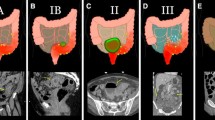Abstract
Purpose
Computed tomography (CT) is the most appropriate imaging modality for the assessment of acute diverticulitis at the emergency unit. The aim of this study was to determine the clinical outcome of the patients presented first time with symptoms of acute diverticulitis and low CRP values.
Methods
Two-hundred patients, who presented with the symptoms of acute diverticulitis and had CRP values under 150 mg/L, underwent abdominal CT examination on admission to Oulu University Hospital. The clinical parameters and radiological findings were compared in relation to clinical outcome both by means of univariate and multivariate analyses.
Results
Seventy-one (35.5 %) of the 200 patients presented on admission with complicated diverticulitis. CRP values between 100 and 150 mg/L predicted complicated disease, but the mean values of CRP between uncomplicated disease, 89 mg/L ± 39, and complicated disease, 101 mg/L ± 39, did not differ significantly. Free intra-abdominal fluid in CT was the only independent risk factor of the need for interventional therapy and treatment in the intensive care unit. Longevity of the patients and free fluid in CT predicted significantly prolonged hospitalization. Mortality was 1 % and older patients were significantly affected. The recurrence rate of acute diverticulitis was 24 % (43/177) in the whole group and 18 % (23/129) after uncomplicated diverticulitis.
Conclusions
Low CRP values do not reliably predict uncomplicated disease in patients presented first time at the emergency unit with acute diverticulitis. We recommend that the need for abdominal CT is carefully evaluated according to the patient’s clinical status, always even when the CRP value is under 150 mg/L.
Similar content being viewed by others
References
Ferzoco LB, Raptopoulos V, Silen W (1998) Acute diverticulitis. N Engl J Med 338:1521–1526
Etxioni DA, Mack TM, Beart RW Jr, Kaiser AM (2009) Diverticulitis in the United States: 1998–2005. Changing patterns of disease and treatment. Ann Surg 249:210–217
Biondo S, Golda T, Kreisler E, Espin E, Vallribera F, Oteiza F, Codina-Casador A, Fujadas M, Flor B (2014) Outpatient versus hospitalization management for uncomplicated diverticulitis: a prospective. multicenter randomized trial (DIVER trial). Ann Surg 259:38–44
van de Wall BJ, Draaisma WA, van der Kaaij RT, Consten EC, Wiezer MJ, Broeders IA (2013) The value of inflammation markers and body temperature in acute diverticulitis. Color Dis 15:621–616
Mäkelä J, Klintrup K, Takala H, Rautio T (2015) The role of C-reactive protein in prediction of the severity of acute diverticulitis in an emergency unit. Scand J Gastroenterol 50:536–541
Hinchey EJ, Schaal PG, Pischard GK (1978) Treatment of perforated diverticular disease. Adv Surg 12:85–90
Andeweg CS, Knobben L, Hendriks JC, Bleichrodt RP, van Gloor H (2011) How to diagnose acute diverticulitis. Ann Surg 253:940–946
Sallinen V, Leppäniemi AK, Mantula PJ (2015) Staging of acute diverticulitis based on clinical, radiologic and physiologic parameters. J Trauma Care Surg 78:543–551
Lameris W, van Randen A, van Gulik TM, Busch ORC, Winkelhagen J, Bossuyt PMM, Stoker J, Boermeester MA (2010) A clinical decision to establish the diagnosis of acute diverticulitis at the emergency department. Dis Colon Rectum 53:896–904
Tursi A, Elisei W, Bradimarte G, Giorgetti GM, Aiello F (2010) Predictive value serologic markers of degree of histologic damage in acute uncomplicated colonic diverticulitis. J Clin Gastroenterol 44:702–706
Käser SA, Fankhauser G, Glauser PM, Toia D, Maurer GA (2010) Diagnostic value of inflammation markers in predicting perforation in acute sigmoid diverticulitis. World J Surg 34:2717–2732
Nizri E, Spring S, Ben-Yehuda A, Kharib M, Klausner J, Greenberg R (2014) C-reactive protein as a marker of complicated diverticulitis in patients on anti-inflammatory medication. Technol Coloproctol 18:145–149
Feingold D, Steele SR, Lee S, Kaiser A, Boushey R, Bule WD, Rafferty JF (2014) Practice parameters for the treatment of sigmoid diverticulitis. Dis Colon Rectum 57:284–294
Humes DJ (2012) Diagnosing and managing acute diverticulitis. Practioner 256:21–23
Abbas MA, Cannom RR, Chiu VY, Burchette RJ, Radner GW, Haigh PI, Etzioni DA (2012) Triage of patients with acute diverticulitis: are some inpatients candidates for outpatient treatment. Color Dis 15:451–457
Sallinen VJ, Mentula PJ, Leppäniemi AK (2014) Nonoperative treatment of perforated diverticulitis with extraluminal air is safe and effective in selected patients. Dis Colon Rectum 57:875–881
Lidsky ME, Thacker JKM, Lagoo-Deenadayalan SA, Scarborough JE (2012) Advancer age is an independent predictor for increased morbidity and mortality after emergent surgery for diverticulitis. Surgery 152:465–472
Jacobs DO (2007) Clinical practice. Diverticulitis. NEJM 357:2057-2066
Salem TA, Molloy RG, Dwyer PJ (2007) Prospective, five-year follow-up study of patients with symptomatic uncomplicated diverticular disease. Dis Colon Rectum 50:1460–1464
Trenti L, Kreisler E, Galvez A, Golda T, Frago R, Biondo S (2015) Long-term evolution of acute colonic diverticulitis after successful medical treatment. World J Surg 39:266–274
Rose J, Parina RP, Faiz O, Chang DC, Talamini MA (2015) Long-term outcomes after initial presentation of diverticulitis. Ann Surg Feb (Epub ahead of print)
Lamb MN, Kaiser AM (2014) Elective resection versus observation after nonoperative management of complicated diverticulitis with abscess: a systematic review and meta-analysis. Dis Colon Rectum 57:1430–1440
Morris AM, Regenbogen SE, Hardiman KM, Hendren S (2014) Sigmoid diverticulitis: a systematic review. JAMA 311:287–297
Author information
Authors and Affiliations
Corresponding author
Rights and permissions
About this article
Cite this article
Mäkelä, J.T., Klintrup, K. & Rautio, T. The role of low CRP values in the prediction of the development of acute diverticulitis. Int J Colorectal Dis 31, 23–27 (2016). https://doi.org/10.1007/s00384-015-2410-8
Accepted:
Published:
Issue Date:
DOI: https://doi.org/10.1007/s00384-015-2410-8




